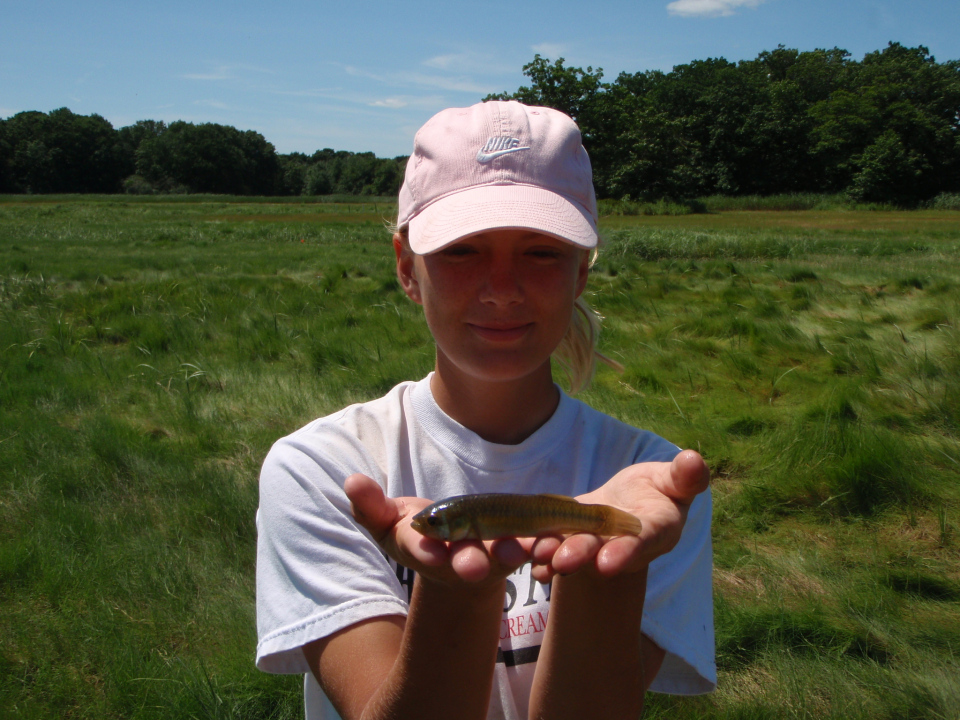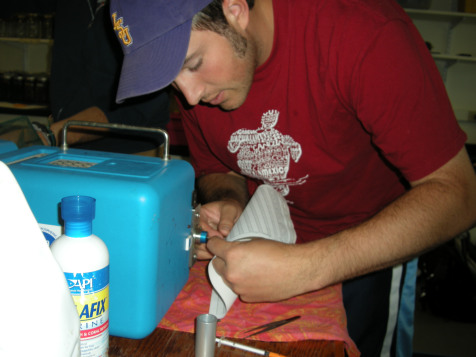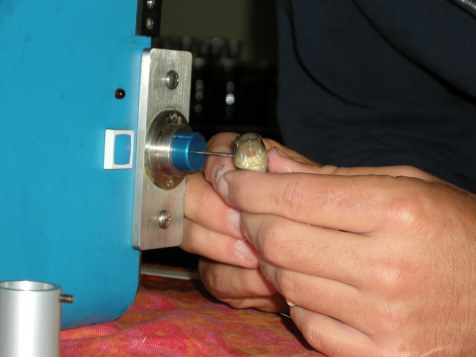
We all know that fertilizer grows plants, but can it grow fish? The answer turns out to be yes in salt marshes according to a new TIDE paper published in Marine Ecology Progress Series by Konner Lockfield and John Fleeger of Louisiana State University and Linda Deegan of the Marine Biological Laboratory. After six years of nutrient enrichment at the landscape scale (350-500m of tidal creek length, a total area of 60,000 m2, the abundance and biomass of the dominant marsh fish, the mummichog Fundulus heteroclitus, increased by up to 60%.
How does fertilizer make fish?
“Of course fish don’t directly eat the fertilizer,” John said in an email. “Fertilizer helps plants and algae grow and even improves the nutritional value of these primary producers. In salt marshes, snails and a legion of small crustaceans (including grass shrimp, amphipods, isopods, and copepods) increase in abundance because their food supply is enhanced. [Mummichogs] forage for these small invertebrates. The increased amount and value of food below mummichogs on the trophic ladder leads to a “bottom-up” stimulation of mummichogs that was started by the addition of fertilizer.”
This paper is the first to experimentally demonstrate bottom-up control on the secondary production of salt-marsh fish.
It is the first study of it’s kind because fish are highly mobile and cover a lot of ground, er, water. Mummichogs have a home range of 300-500 m, which is the length of tidal creek fertilized by the TIDE Project.
Because of the size of the experiment, the study required tremendous effort. Konner, the lead author, coordinated a swarm (a dozen) of undergraduates, high school, graduate students, and post-docs to collect and tag 7828 mummichogs with coded-wire tags for this large-scale mark and recapture study. Konner was understated when he said, “It was a lot of work.”
A surprising finding from the study is that in the fertilized creeks fish had more algae in their guts. “Mummichogs are omnivores meaning they consume plant matter, algae, and animals,” John said. Previous TIDE work has shown that can exert strong top-down control on algae in certain scenarios.
John asserts, however, “We aren’t sure why mummichogs eat more algae in fertilized creeks. Animal prey is richer in protein than algae and should promote faster growth. Theoretically then, mummichogs should prefer animal prey and should increase animal consumption when the food web is stimulated.”
Konner suggests another hypothesis, “One possibility is that they’re eating it incidentally as they consume more benthic prey.” Konner agrees with John’s assessment that, “More research is needed to examine the behavioral and dietary preferences in mummichogs and the nutritional content of the various food sources when grown under fertilization.”
The fertilization conducted by the TIDE Project mimics run-off of nutrients (nitrogen and phosphorus) from agriculture and sewage sources. The current study suggests positive effects of this run-off on fish production in the short-term. We remain uncertain, however, about long-term effects, which may be detrimental. For instance, we have found that chronic enrichment fragments the vegetated low marsh. Loss of this habitat may ultimately affect fish production in the long run. We continue to study this question to understand the fate of our marshes in ever-changing conditions.
This work was funded by the National Science Foundation under Grant Nos. 0816963, 0923689 and 0423565.
Fundulus fun facts – the term ‘mummichog’ is an Indian term meaning ‘going in crowds’. They are also called ‘killifish’ (as are a host of other minnows). ‘Kill’ comes from the Dutch word for river or stream. Thus, killifish are river/stream fish!
This publication is part of Konner Lockfield’s Master’s thesis from the TIDE Project. He is currently employed the Audubon Aquarium of the Americas (lucky!) in New Orleans, Louisiana.
Dr. John Fleeger is emeritus at Louisiana State University and though he technically retired, he stays active as an adjunct professor at the University of Missouri at Kansas City where he teaches Ecosystem Science and Ecotoxicology and is able to spend more time with his grandkids.
Dr. Linda Deegan is a Senior Scientist at the Marine Biological Laboratory but decided that wasn’t enough work so she is currently on leave as a Program Director at the National Science Foundation in Washington, DC.
Lockfield, K., J.W. Fleeger, and L.A. Deegan. 2013. Mummichog Fundulus heteroclitus responses to long-term, whole-ecosystem nutrient enrichment. Marine Ecology Progress Series, 492:211-222.
– David

